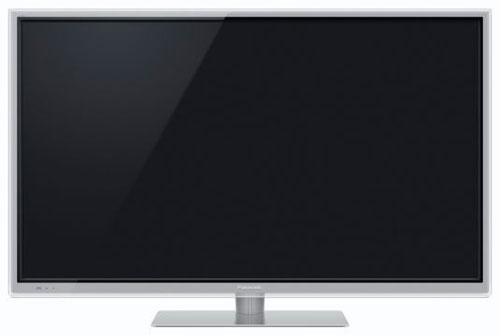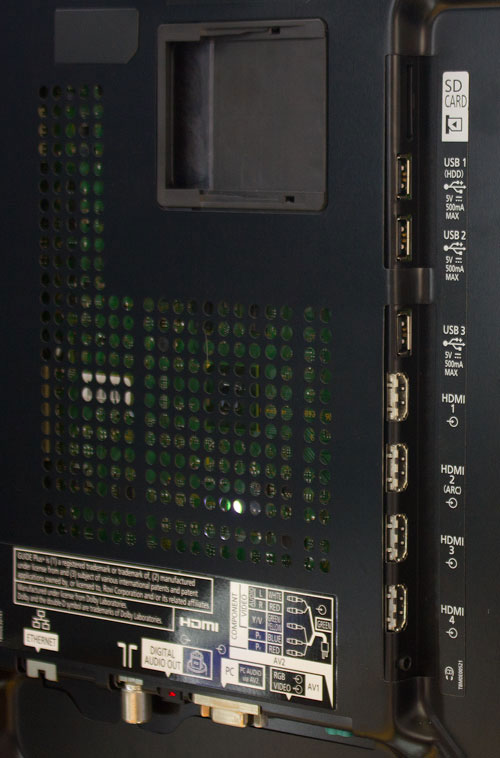Traditionally a Plasma company, Panasonic has been following industry trends lately, increasing the size and diversity of its “LED TVs” (LCD TVs featuring LED edge-lighting). In the (paraphrased) words of one company representative, the Japanese giant is still committed to Plasma, but it would be pointless to ignore the popularity of “LED TV”, which has absolutely won the flat-panel marketing war. Or, put another way, the TV manufacturer has a factory dedicated to pumping out Liquid Crystal televisions, and if that’s what the mass market wants, then it would be foolish not to utilise it.
<!-- google_ad_client = 'pub-2887677957235196'; google_ad_slot = '4990177225'; google_ad_width = 336; google_ad_height = 280; //-->
The Viera ET50 sits two rungs below Panasonic’s top-end WT series of LED LCDs, and features support for “Progressive Full HD 3D” (unlike the cheaper Passive 3D system found in the lower ET5 series), 800hz Backlight Scanning to combat LCD motion blur, and 4 HDMI inputs. The Panasonic TX-L42ET50B we’re reviewing today also features an IPS panel, a type of LCD panel that has received a popularity boost thanks to Apple’s inclusion (and promotion) of it in many of its products, such as the iPad. IPS LCD panels tend to feature lower contrast performance (poorer black levels) than some competing LCD types, but its main claim to fame is its wide viewing angles: although nowhere near Plasma levels, colours don’t wash out as much when the screen is viewed from the sides.
Of course, “Smart TV” is also the new big thing on TV makers’ checklists; indeed, Panasonic has branded its lineup “SMART VIERA” to really push the message. Unsurprisingly, the TX-L42ET50 features built-in wireless networking for easy access to the internet and world wide web.
Let’s see if Panasonic’s LCD HDTV displays can hold their own against the competition!
Note: The specific model we tested was the Panasonic TX-L42ET50B which is the British 3-pin-plug version. While we did not review the larger, 47-inch TX-L47ET50B/ TX-L47ET50, there shouldn’t be any significant difference in picture performance given similar specifications within the ET50 range.

The Panasonic TX-L42ET50’s styling is breathtaking, and once again, appears to be heavily influenced by Samsung’s excellent LCD TV designs. However, Panasonic has actually improved on the source material both in terms of style and build quality. The LCD screen is surrounded by a gloss black border, which is in turn framed by silver. This two-tone combination is covered in glass-like acrylic, which protrudes by about 0.9cm outwards, meaning that the edge of the bezel takes on the colour of the viewer’s room. Build quality is excellent; squeezing the edges of the bezel doesn’t cause it to pinch or expand.
The stand is made from sleek silver metal, and assembles fairly easily.
The Panasonic TX-L42ET50B features 4 HDMI inputs, and with the use of provided adapter cables, SCART, Component, and Composite devices can be hooked up (one of each; in fact, the Component/Composite input is shared). Unlike the company’s European Plasma TVs, an analogue VGA input IS present, useful for laptops that don’t feature an HDMI output. There’s also an Ethernet port for hard-wired network connections, although the TX-L42ET50 features a built-in wireless receiver, so we didn’t use it.
 |
| Rear: 4 x HDMI, VGA, Component, SCART, aerial, ethernet & audio outs |
The same user menus found on all of the 2011 and 2012 Plasma and LCD Panasonic HDTVs are present on the TX-L42ET50B, and the menus work perfectly. We’re happy to see that as on the recently reviewed ST50 Plasma, the “True Cinema” mode has been taken to a new level with extra picture calibration controls (which have to be unlocked in the Setup menu).
![[Picture] menu](https://www.hdtvtest.co.uk/news/wp-content/uploads/2018/04/hdtv_Panasonic-TXL42ET50_picture1.jpg) |
| [Picture] menu |
The workings of the picture controls on the Panasonic televisions varies depending on the display type (LCD/Plasma) and the model. The [Contrast] control on the TX-L42ET50 also adjusts the intensity of the LED light sources; unlike on many other LCD TVs, where backlight and contrast are two separate controls. In fact, the Panasonic ET50 crushes out all “above white” shades when it’s in the “True Cinema” mode (but not the others), which is fine, since there is some leeway in the correct way to set this control.
The “True Cinema” mode is the mode which Panasonic has designed to match a studio monitor as closely as possible – an accurate, hands-off mode which just passes through images without alteration. That’s not the only difference, though. On the Panasonic LCDs, selecting “True Cinema” disables the dynamic backlighting. Dynamic backlighting is where the screen illumination (in this case, the intensity of the LEDs at the sides of the screen) is raised or lowered to match the video. So, when a dark scene comes on, the lights dim, when a bright scene is shown, they brighten. This is done to enhance the apparent contrast performance of the LCD screen and provide deeper blacks, at the expense of shadow details and colour saturation during these moments. Panasonic has probably disabled it in the “True Cinema” mode because some video enthusiasts find the darkening and brightening effect distracting, although ideally the choice would be given.
| Jump To: 1. DesignNext: Calibration3. Performance |
jQuery(document).ready(function($) { var toc = $("#tableofcontents").html(); $("#tablecontents").html(toc); });